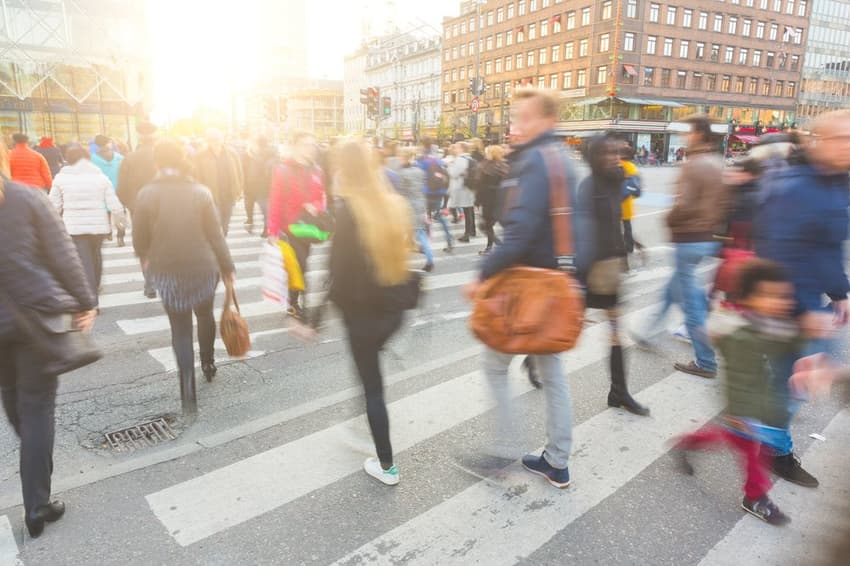Here's where Denmark's foreign residents live and where they come from

Denmark's total population reached 5.78 million in the first quarter of 2018, increasing by just over 0.5 percent against the same period last year. People with foreign heritage make up 13.3 percent of the country's residents.
In total, there are 5,781,190 people living in Denmark, according to the latest figures from Statistics Denmark (DST) from the first quarter of 2018.
Of those, 770,397 are of foreign heritage. This includes people from all corners of the globe -- with many of The Local's readers (and staff) among them.
The figures, from official stats agency DST, provide a lot of information as to the makeup of Denmark’s expat and immigrant population -- but first a few definitions need to be clarified.
DST's statistics bank categorises people considered not of Danish heritage into two groups: ‘immigrants’ and ‘descendants’ of immigrants (‘efterkommere’ in Danish).
A person is considered to have Danish heritage if she or he has at least one parent who is a Danish citizen and was born in Denmark. People defined as ‘immigrants’ and ‘descendants' do not fulfil those criteria. The difference between the two is that an ‘immigrant’ was born outside of Denmark, while a ‘descendant' was born in Denmark.
The numbers are based on data from personal registration (CPR) number databases, which include information on place of birth, citizenship and parents, provided parents also have information in the CPR database.
The 770,397 figure is broken down by DST into 247,873 immigrants from Western countries; 343,805 immigrants from non-Western countries; 29,056 descendants from Western countries and 149,663 descendants from non-Western countries.
That breakdown makes a further definition necessary: all EU countries, along with Andorra, Australia, Canada, Iceland, Liechtenstein, Monaco, New Zealand, Norway, San Marino, Switzerland, the United States and the Vatican are considered ‘Western’. Everywhere else is ‘non-Western’.
READ ALSO: Is life in Denmark impossible without a personal registration number?
They may have moved for love, for work, out of necessity or just to try something new; here's a closer look at just where people in these groups come from and where they end up.
Aside from Danish, the most common nationality in the current population figures is Polish, with a total of 40,601 individuals across Denmark. Second is Syrian, with 35,441; then Turkish (32,924), German (29,804) and Romanian (26,299).
Other nationalities include 2,479 Australians, 11,710 from China, 9,351 Americans and 14,811 from the United Kingdom.
Of Denmark’s Scandinavian neighbours, 14,161 Swedes have crossed the Øresund bridge to settle in Denmark, joining 15,752 Norwegians.
The map below shows the distribution by nationality of those 'first generation' movers to Denmark.
if("undefined"==typeof window.datawrapper)window.datawrapper={};window.datawrapper["DCsIb"]={},window.datawrapper["DCsIb"].embedDeltas={"100":694,"200":551,"300":456,"400":456,"500":400,"700":400,"800":400,"900":400,"1000":400},window.datawrapper["DCsIb"].iframe=document.getElementById("datawrapper-chart-DCsIb"),window.datawrapper["DCsIb"].iframe.style.height=window.datawrapper["DCsIb"].embedDeltas[Math.min(1e3,Math.max(100*Math.floor(window.datawrapper["DCsIb"].iframe.offsetWidth/100),100))]+"px",window.addEventListener("message",function(a){if("undefined"!=typeof a.data["datawrapper-height"])for(var b in a.data["datawrapper-height"])if("DCsIb"==b)window.datawrapper["DCsIb"].iframe.style.height=a.data["datawrapper-height"][b]+"px"});
The pattern is a little different for the second group defined by Denmark as ‘descendents’: those that were born in Denmark to at least one non-Danish parent.
Here, the five biggest contributing countries are Turkey (30,428), Lebanon (13,948), Pakistan (11,024) Iraq (10,867) and Somalia (9,397). Poland is sixth with 6,299 descendants.
Other nationalities include Bosnia-Herzegovina (6,084), the former Yugoslavia (5,941), the UK (1,569), USA (742), Australia (133), Sweden (2,147) and Norway (1,606).
The map below shows the distribution of foreign nationalities living in Denmark.
if("undefined"==typeof window.datawrapper)window.datawrapper={};window.datawrapper["pFOoS"]={},window.datawrapper["pFOoS"].embedDeltas={"100":677,"200":495,"300":456,"400":439,"500":414,"700":400,"800":400,"900":400,"1000":400},window.datawrapper["pFOoS"].iframe=document.getElementById("datawrapper-chart-pFOoS"),window.datawrapper["pFOoS"].iframe.style.height=window.datawrapper["pFOoS"].embedDeltas[Math.min(1e3,Math.max(100*Math.floor(window.datawrapper["pFOoS"].iframe.offsetWidth/100),100))]+"px",window.addEventListener("message",function(a){if("undefined"!=typeof a.data["datawrapper-height"])for(var b in a.data["datawrapper-height"])if("pFOoS"==b)window.datawrapper["pFOoS"].iframe.style.height=a.data["datawrapper-height"][b]+"px"});
Denmark’s foreign population is spread across the country, with a clear concentration in capital Copenhagen as well as the three next largest urban centres – Aarhus, Odense and Aalborg.
Unsurprisingly, by far the most foreign residents live in Copenhagen’s municipality, with 152,425 foreign residents making up a large proportion – around a quarter – of the 613,288 population of Copenhagen Municipality (Greater Copenhagen has a population of 1.8 million).
In comparison, 57,013 of the 340,421 people living in Aarhus Municipality fall into one of the ‘foreign resident’ categories.
If you’re a foreigner living outside of one of the larger Danish cities, you may feel a little more isolated. But you’re not completely alone.
Even on Christiansø – a tiny island in the Baltic Sea north of Bornholm and Denmark’s smallest municipality – three of the 83 residents are foreign.
READ ALSO: Half of Danish resident permits go to EU citizens
Comments
See Also
In total, there are 5,781,190 people living in Denmark, according to the latest figures from Statistics Denmark (DST) from the first quarter of 2018.
Of those, 770,397 are of foreign heritage. This includes people from all corners of the globe -- with many of The Local's readers (and staff) among them.
The figures, from official stats agency DST, provide a lot of information as to the makeup of Denmark’s expat and immigrant population -- but first a few definitions need to be clarified.
DST's statistics bank categorises people considered not of Danish heritage into two groups: ‘immigrants’ and ‘descendants’ of immigrants (‘efterkommere’ in Danish).
A person is considered to have Danish heritage if she or he has at least one parent who is a Danish citizen and was born in Denmark. People defined as ‘immigrants’ and ‘descendants' do not fulfil those criteria. The difference between the two is that an ‘immigrant’ was born outside of Denmark, while a ‘descendant' was born in Denmark.
The numbers are based on data from personal registration (CPR) number databases, which include information on place of birth, citizenship and parents, provided parents also have information in the CPR database.
The 770,397 figure is broken down by DST into 247,873 immigrants from Western countries; 343,805 immigrants from non-Western countries; 29,056 descendants from Western countries and 149,663 descendants from non-Western countries.
That breakdown makes a further definition necessary: all EU countries, along with Andorra, Australia, Canada, Iceland, Liechtenstein, Monaco, New Zealand, Norway, San Marino, Switzerland, the United States and the Vatican are considered ‘Western’. Everywhere else is ‘non-Western’.
READ ALSO: Is life in Denmark impossible without a personal registration number?
They may have moved for love, for work, out of necessity or just to try something new; here's a closer look at just where people in these groups come from and where they end up.
Aside from Danish, the most common nationality in the current population figures is Polish, with a total of 40,601 individuals across Denmark. Second is Syrian, with 35,441; then Turkish (32,924), German (29,804) and Romanian (26,299).
Other nationalities include 2,479 Australians, 11,710 from China, 9,351 Americans and 14,811 from the United Kingdom.
Of Denmark’s Scandinavian neighbours, 14,161 Swedes have crossed the Øresund bridge to settle in Denmark, joining 15,752 Norwegians.
The map below shows the distribution by nationality of those 'first generation' movers to Denmark.
Here, the five biggest contributing countries are Turkey (30,428), Lebanon (13,948), Pakistan (11,024) Iraq (10,867) and Somalia (9,397). Poland is sixth with 6,299 descendants.
Other nationalities include Bosnia-Herzegovina (6,084), the former Yugoslavia (5,941), the UK (1,569), USA (742), Australia (133), Sweden (2,147) and Norway (1,606).
The map below shows the distribution of foreign nationalities living in Denmark.
Denmark’s foreign population is spread across the country, with a clear concentration in capital Copenhagen as well as the three next largest urban centres – Aarhus, Odense and Aalborg.
Unsurprisingly, by far the most foreign residents live in Copenhagen’s municipality, with 152,425 foreign residents making up a large proportion – around a quarter – of the 613,288 population of Copenhagen Municipality (Greater Copenhagen has a population of 1.8 million).
In comparison, 57,013 of the 340,421 people living in Aarhus Municipality fall into one of the ‘foreign resident’ categories.
If you’re a foreigner living outside of one of the larger Danish cities, you may feel a little more isolated. But you’re not completely alone.
Even on Christiansø – a tiny island in the Baltic Sea north of Bornholm and Denmark’s smallest municipality – three of the 83 residents are foreign.
READ ALSO: Half of Danish resident permits go to EU citizens

Join the conversation in our comments section below. Share your own views and experience and if you have a question or suggestion for our journalists then email us at [email protected].
Please keep comments civil, constructive and on topic – and make sure to read our terms of use before getting involved.
Please log in here to leave a comment.